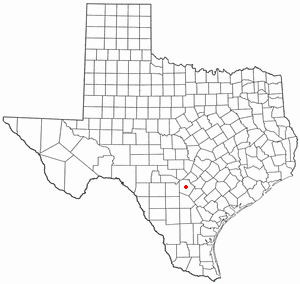San Pedro Springs facts for kids
Quick facts for kids San Pedro Springs |
|
|---|---|

Location of San Pedro Springs
|
|
| Location | San Antonio, Texas, U.S.A |
| Spring source | Edwards Aquifer |
| Elevation | 660 ft (201 m) above sea level |
| Type | Karst springs |
| Provides water for | San Pedro Creek, San Antonio River |
San Pedro Springs is a group of natural water sources in Bexar County, Texas, in the United States. These springs provide water for San Pedro Creek. This creek then flows into the San Antonio River. Other springs, like the San Antonio Springs, also add water to the San Antonio River.
Contents
What are San Pedro Springs?
The San Pedro Springs are located in the Tobin Hill area of San Antonio. They are about 1.6 miles (2.6 km) north of Downtown San Antonio. Most of these springs are found inside San Pedro Springs Park. This park is actually the oldest park in Texas!
How the Springs Get Water
The water for these springs comes from a huge underground water supply called the Edwards Aquifer. This water travels up to the surface through cracks in the Earth's crust. These cracks are called faults. They are part of a larger area known as the Balcones Escarpment.
There are 13 main springs at San Pedro. However, they do not flow very often anymore. This is because a lot of water is pumped out of the Edwards Aquifer for people to use.
Nature Around the Springs
The area around the Balcones Fault is also important for nature. It acts like a natural border for where some plants grow. For example, the California Fan Palm (also known as Washingtonia filifera) usually grows only west of the San Pedro Springs.
A Look Back in Time: History of the Springs
People have been using the San Pedro Springs for a very long time. Scientists have found old tools and items from Paleo-Indian cultures here. These items show that people were using the springs over 12,000 years ago!
Later, a group of Coahuiltecan Native Americans, called the Payaya people, lived near the springs. They called their village Yanaguana. This name means "place of refreshing waters."
Spanish Explorers and Settlements
A Spanish missionary named Father Isidro Félix de Espinosa gave the springs their current name in 1709. Some historians think that another explorer, Álvar Núñez Cabeza de Vaca, might have visited the springs even earlier, in 1535. If this is true, it would make the springs one of the oldest historical sites in North America. It would also make San Pedro Springs Park the second oldest park in America, after Boston Common.
In 1718, Governor Martín de Alarcón tried to start a settlement near the springs. He called it Villa de Béxar. Also in 1718, another Spanish missionary, Antonio de San Buenaventura y Olivares, built a mission nearby. He named it San Antonio de Valero. This was the first lasting European settlement in San Antonio.
Water Use and Recreation
In the 1730s, people built a special water channel called an acequia. This channel carried water from the springs to the city. It was used for watering crops and for homes.
By the 1870s, the springs became a popular spot for fun activities. People would go boating, fishing, and swimming there.
A public swimming pool was built in the park in 1922. It was replaced in 1954 and again in 2000.
Images for kids



